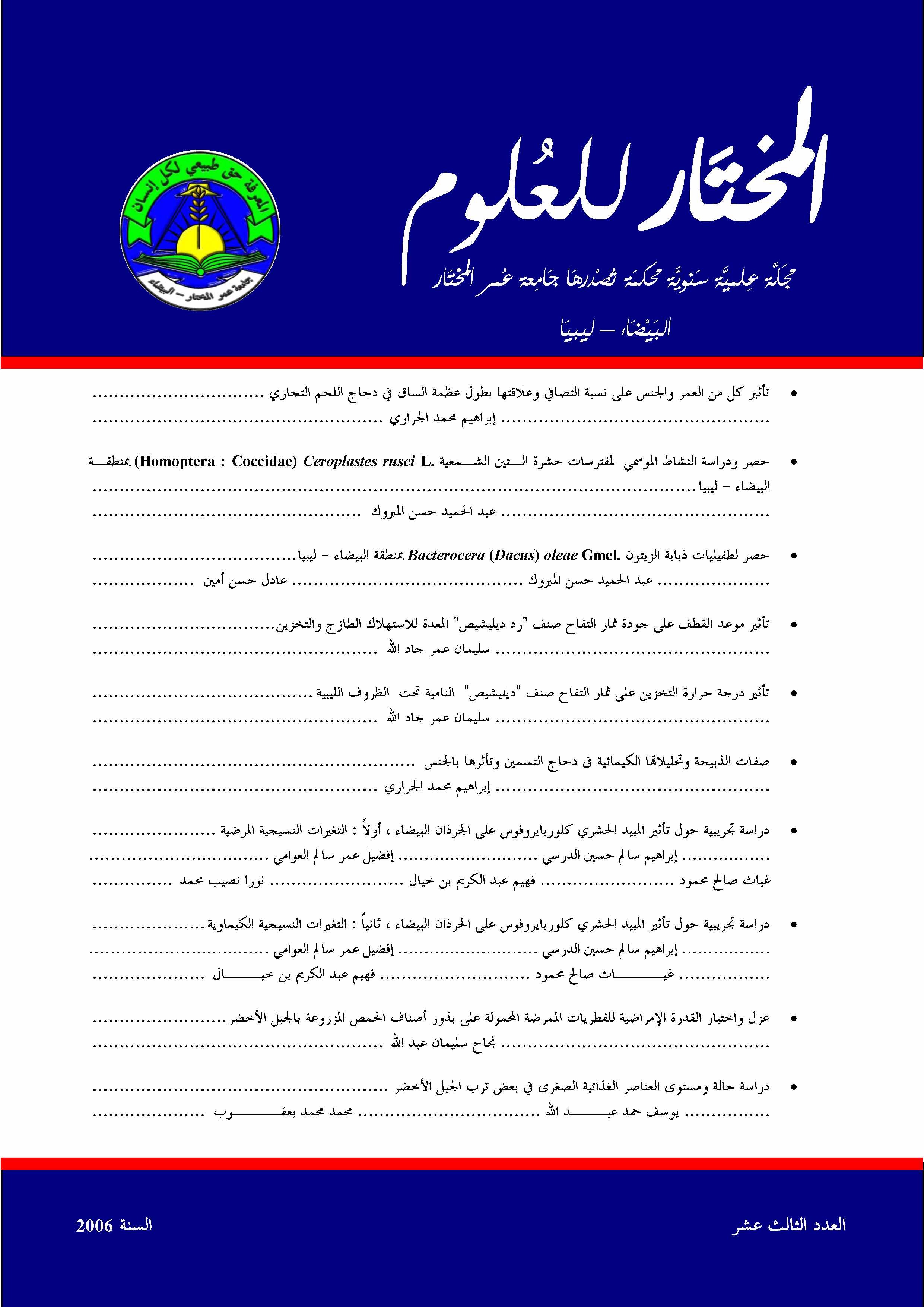Carcass Characteristics and it's Chemical Composition of Broiler Chickens as Influenced by Sex
DOI:
https://doi.org/10.54172/mjsc.v13i1.656Abstract
Fifty birds of broiler chicken at five weeks of age were chosen randomly and used in this experiment (25 males and 25 females). Birds live-body weights were recorded before slaughtering. After slaughtering, the weight of the carcass (before and after feathering), feathers, legs, fat, gizzard (without mucosa), heart and liver (without gall bladder) were recorded. Also, Breast before and after skinning, drumstick and thigh weights (without skin) were recorded and samples of these cuts were used for chemical analysis.
Results indicated that live body weights and weight after slaughtering were significantly (P<0.01) higher for males than females, and males were higher for approximately 5.63 and 5.74% times, respectively than females. The results also showed that there were no significant differences between males and females for skinned breast weight and skin of the drumstick weight, while breast skin was significantly higher (P<0.05) for females than males (24.29 vs. 19.17 gm, respectively). Weights of feathers, legs, weight after feathering and liver without gall bladder were significantly higher for males than females. While internal fat and visceral fat the differences were not significant between both sexes. Correlation of live body weight and weight after slaughtering (P<0.01), head weight (P<0.05) and feather weight and final body weight (P<0.01) were positive.
Contents of fat, and crude protein percentages were significantly higher (P<0.01) for males breast than females, while ash contents were not significant. In contrast, moisture contents were significantly higher (P<0.05) for females drumstick than males (75.16 vs. 72.68%) and (4.02 vs. 3.35%), respectively.
It can be concluded that sex has an effect on most of carcass characteristics and their chemical composition although males were superior than females.
Downloads
References
AOAC, (1990). Official Methods of Analysis (15th ed.). Association of Official Analytical Chemists. Washington, DC., USA.
Azahan, E., (1984). Carcass yield of broilers. MARDI Res. Bull. 12, 1:107-115.
Brake , J.; Havensten, G.B.; Scheideler, S.E.; Ferket, P.R., and D.V. Rives, (1993). Relationship of sex , age and body weight to broiler carcass yield and offal production. Poultry Science 72:1137-1145.
De Marchi, M.; Cassandro, M.; Lunardi, E.; Baldan, G. and P.B. Siegel, (2005). Carcass characteristics and qualitative meat traits of the Pavovana breed of chicken. International Journal of Poultry Science 4(4):233-238.
Duncan, D. B., (1955). Multiple range and multiple F Tests. Biometrics 11: 1-42.
Grey, T.C.; Robinson, D.; Jones, J.M.; Stock, S.W. and N.L. Thomas., (1983). Effect of Age and sex on the composition of muscle and skin from a commercial broiler. British Poultry Science, 24:219-231.
Hayse, P.L. and Marion, W.W., (1973). Eviscerated yield, component parts, and meat, skin and bone ratios in the chicken broiler. Poultry Science 52:718-722.
Mcnally, E.H. and N.H. Spicknall, (1949). Meat yield from live, dressed and eviscerated Rhode Island Red males of broiler, fryer and light roaster weights. Poultry Science 28:562-567.
NASS, (2000), National Agricultural Statistics Service, Agriculture Statistics Board. Poultry Slaughter report, United States Department of Agriculture, Washington, DC.
Pakdel, A.; Van Arendonk, J.A.M.; Vereijken, A.L.J. and H. Bovenhuis, (2001). Heritability of ascites related traits in broilers. The 52nd Annual meeting of the European Association for Animal Production, Budapest, August 2001.
SAS, (1990). SAS/STAT.”Guide for personal Computers” SAS Inst.,Inc Cary,N.C,USA.
Young, L.L.; Northcutt, J.K.; Buhr, R.J.; Lyon, C.E. and G. O. Ware, (2001). Effects of age, sex and duration of postmortem aging on percentage yield of parts from broiler chicken carcasses. Poultry Science 80:376-379.
Walters, R.E.; May, K.N. and P.D. Rogers, (1963). Relations of weights and sizes of broiler parts to carcass weights. U.S.D.A. Marketing Res. Report 604:30pp.
Watts, G. and C. Kennett, (1995). The Broiler Industry. Poultry tribune (September):6-18.
Downloads
Published
How to Cite
License

This work is licensed under a Creative Commons Attribution-NonCommercial 4.0 International License.
Copyright of the articles Published by Almukhtar Journal of Science (MJSc) is retained by the author(s), who grant MJSc a license to publish the article. Authors also grant any third party the right to use the article freely as long as its integrity is maintained and its original authors and cite MJSc as original publisher. Also they accept the article remains published by MJSc website (except in occasion of a retraction of the article).










